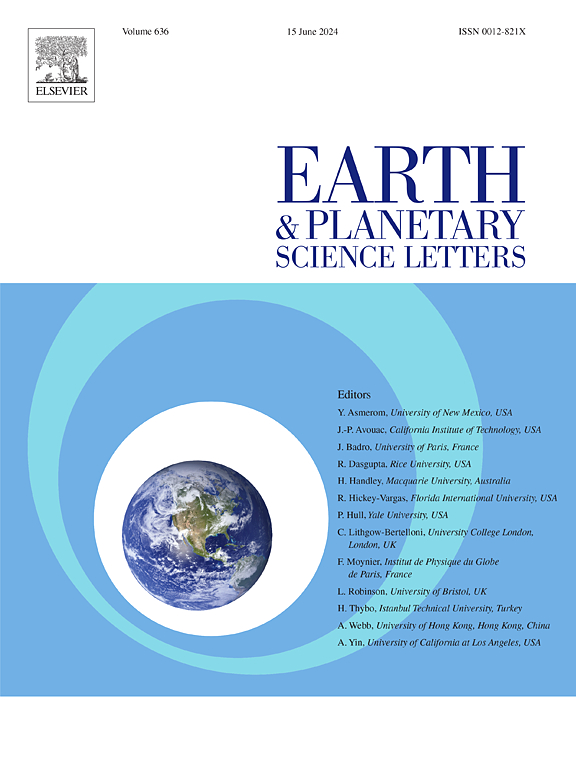有机碳、海平面和碳酸盐风化作用对海相碳同位素扰动的控制
IF 4.8
1区 地球科学
Q1 GEOCHEMISTRY & GEOPHYSICS
引用次数: 0
摘要
希尔南梯同位素碳偏移(HICE)记录了晚奥陶世希尔南梯冰期全球碳循环的剧烈扰动。在全球记录中,HICE的特征是持续时间和振幅的变化,但对其最终驱动因素和对观测到的变率的控制却知之甚少。本文综合整理了长江陆架万河和双河两个连续海南天剖面的地球化学资料和配对碳、钙同位素记录。结果表明,陆架上有机碳同位素(δ13Corg)值的横向梯度高达4‰,由近岸向近海递减。万河和双河剖面碳酸盐碳同位素(δ13Ccarb)数据也表现出明显的变异性,不能完全用原生矿物学变化或早期海相成岩作用来解释。因此,我们将空间δ13CDIC模式解释为至少部分反映了海水溶解无机碳同位素(δ13CDIC)值的陆架尺度非均质性。结果表明,大量有机碳埋藏可能触发了HICE,而海平面变化随后驱动了海水δ13CDIC值的非同步、空间异质性变化。此外,与同冰期海平面下降有关的碳酸盐风化作用增强,扩大了区域海相δ13CDIC值的空间异质性。在整个希尔南天冰期的中央陆架地区观测到中等的δ13Corg变化(<+2‰),表明该冰期全球碳循环扰动的幅度比通常认为的要小。本文章由计算机程序翻译,如有差异,请以英文原文为准。
Organic carbon, sea level and carbonate weathering controls on marine carbon isotope perturbations across the Hirnantian glaciation
The Hirnantian isotopic carbon excursion (HICE) records a dramatic perturbation to the global carbon cycle across the Late Ordovician Hirnantian glaciation. The HICE is characterized by variable duration and amplitude in global records, but its ultimate driver, and controls on the observed variability, are poorly understood. Here, we present a comprehensive compilation of geochemical data and paired carbon and calcium isotope records for two continuous Hirnantian sections at Wanhe and Shuanghe on the Yangtze Shelf (South China). Our results reveal a lateral gradient of up to 4 ‰ in organic carbon isotope (δ13Corg) values across the shelf, decreasing from nearshore to offshore. Carbonate carbon isotope (δ13Ccarb) data from the Wanhe and Shuanghe sections also show pronounced variability, which cannot be fully explained by primary mineralogical changes or early marine diagenesis. We therefore interpret the spatial δ13Corg patterns as reflecting, at least in part, shelf-scale heterogeneity in seawater dissolved inorganic carbon isotope (δ13CDIC) values. Our compilation further suggests that substantial organic carbon burial likely triggered the HICE, while sea-level change subsequently drove the asynchronous, spatially heterogeneous changes in seawater δ13CDIC values. Additionally, enhanced carbonate weathering, linked to falling syn-glacial sea-level, amplified the spatial heterogeneity in regional marine δ13CDIC values. Moderate δ13Corg changes (<+2 ‰) are observed in central shelf areas across the Hirnantian glaciation, suggesting that the global carbon cycle perturbations during this ice age were of more modest amplitude than often suggested.
求助全文
通过发布文献求助,成功后即可免费获取论文全文。
去求助
来源期刊

Earth and Planetary Science Letters
地学-地球化学与地球物理
CiteScore
10.30
自引率
5.70%
发文量
475
审稿时长
2.8 months
期刊介绍:
Earth and Planetary Science Letters (EPSL) is a leading journal for researchers across the entire Earth and planetary sciences community. It publishes concise, exciting, high-impact articles ("Letters") of broad interest. Its focus is on physical and chemical processes, the evolution and general properties of the Earth and planets - from their deep interiors to their atmospheres. EPSL also includes a Frontiers section, featuring invited high-profile synthesis articles by leading experts on timely topics to bring cutting-edge research to the wider community.
 求助内容:
求助内容: 应助结果提醒方式:
应助结果提醒方式:


